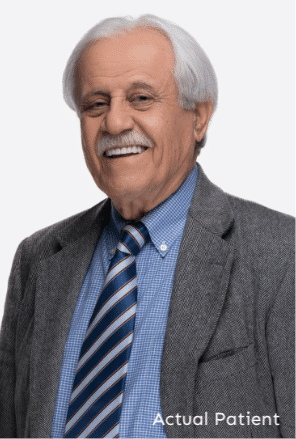NORTHERN VIRGINIA, INCLUDING ARLINGTON, MCLEAN, TYSONS CORNER AND SURROUNDING AREAS
Hypertension has a reputation for being “the” silent killer. But Dr. Lee, Dr. Oh and Dr. Kirsten warn that there is another disorder that should share that moniker. Obstructive sleep apnea (OSA) is a life threatening disorder that affects more than 12 million Americans. According to the American Sleep Apnea Association, most cases are undiagnosed. No wonder most victims of this disorder have no idea that there are treatment options for sleep apnea.
TYPES OF SLEEP APNEA

Actual Patient
The nighttime breathing condition called sleep apnea affects an estimated 12 million people in the United States. There are three different types of sleep apnea:
- Obstructive, the most common type of sleep apnea, where the airway becomes blocked by the tongue and soft tissue collapsing in the throat
- Central, in which the brain does not send breathing signals to your muscles
- Mixed, which combines both obstructive and central sleep apnea
What If Sleep Apnea Is Left Untreated?
Left untreated, sleep apnea causes interruptions in sleep patterns and can lead to additional physical problems during the waking hours. At Galleria Dental Aesthetics, Dr. Lee, Dr. Oh and Dr. Kirsten provide sleep apnea treatment options for obstructive sleep apnea.
HOW IS SLEEP APNEA TREATED?
Treatments for sleep apnea have the common goal of opening the airway. They range from simple adjustments in your sleeping habits to surgery. While continuous positive airway pressure (CPAP) is one of the more common treatments, it isn’t always the most successful. Other treatments include:
- Sleeping on your side–methods to prevent sleeping on your back
- Avoiding alcohol or sedatives that relax muscles
- Weight loss
- CPAP
- Radio frequency waves to shrink throat or tongue tissue
- Laser-Assisted Uvuloplasty (LAUP), surgery to remove the uvula and surrounding tissue
- Tonsillectomy
- Surgery to advance the mandible forward to open the airway
- Mandibular advancement devices (MAD) or mandibular repositioning appliances (MRA)
WHICH TREATMENT OPTION IS RIGHT FOR ME?
Given a choice, most patients would choose the least invasive, non-surgical, and most tolerable treatments. Of those that require medical intervention, the MADs fit that description best. While there are many designs, the basic idea involves anchoring the device to your upper and lower teeth to hold the lower jaw forward during sleep.
ORAL APPLIANCE TREATMENT FOR SLEEP APNEA
Our cosmetic dentists have the advanced training in oral appliance therapy to help patients with sleep apnea. When worn at night, a custom-made oral appliance can keep a sleep apnea patient’s airway open and unobstructed. There are approximately 40 FDA-approved designs available to:
- Reposition how the lower jaw, tongue and soft tissues are positioned in the mouth
- Keep the lower jaw and tongue stabilized
- Add muscle tone to the tongue
An in-depth examination by one of our sleep apnea dentists can help our team determine which type of mouthpiece may help to solve your sleep apnea problem.
Patient Testimonial
“Terrific staff; Joe, Nancy and Bess are consummate professionals and provide the highest level of dental care and service. Highly recommended for anyone in the DC area!!” – Greg B.
ALTERNATIVE TREATMENT METHODS FOR SLEEP APNEA
Sometimes, a combination of therapies is necessary to fully treat sleep apnea, and often this process can take months or even years to determine the most effective approach to solving the problem. Other treatment methods for sleep apnea include:
- Continuous Positive Airway Pressure (CPAP), where the patient wears a mask over the mouth and/or nose while sleeping to deliver pressurized air through a tube to keep the airway clear
- Invasive surgery to reposition the lower jaw or remove excess throat tissue, tonsils, adenoids or uvula
- Lifestyle changes, such as weight loss, exercise, avoidance of alcohol, smoking or taking certain medications and side sleeping
Because there are varying degrees of sleep apnea, what works for one patient may not necessarily work for another. At Galleria Dental Aesthetics, we are committed to helping our sleep apnea patients find solutions for this potentially life-altering condition, and we will work with you for as long as possible until we find the appropriate solution.
EFFECTIVENESS OF MRAS IN TREATING SLEEP APNEA
MRAs have consistently shown a significant improvement of about 50% reduction in respiratory disturbance index (RDI), a clinical measurement of the severity of sleep apnea. While continuous positive airway pressure (CPAP) has shown a 78% reduction in RDI, it may appear to be the most effective treatment for OSA. But there is more to consider.
Patients using CPAP have only a 60-70% compliance rate, meaning that 30-40% of OSA patients depending on CPAP for treatment either are not using their devices properly, or at all. CPAP provides 0% improvement for these patients.
CPAP Vs. MRA
Patients who cannot comply with the inconvenience or discomforts of CPAP may benefit most from an MRA, as its inconvenience and adjustment curve are significantly more tolerable than those of CPAP. MRAs require no permanent change, unlike surgery. For people who must take sedative medications at night, MRAs may overcome the degree of muscle relaxation they cause and prevent the obstruction.
The simple fact that more people accept and use MRAs as they should means that, to the degree that this is an effective treatment, it works because it is used properly.
SCHEDULE A CONSULTATION
If you have symptoms or a diagnosis of obstructive sleep apnea, please contact the neuromuscular dentists at Galleria Dental Aesthetics providing patients with sleep apnea treatment throughout Northern Virginia.
Please call 703.448.1020 to schedule a free consultation with the sleep apnea specialists at Galleria Dental Aesthetics and begin the journey to a good night’s sleep. Our practice serves Tysons Corner, Arlington, Fairfax, Alexandria, McLean, and all of Northern Virginia.






